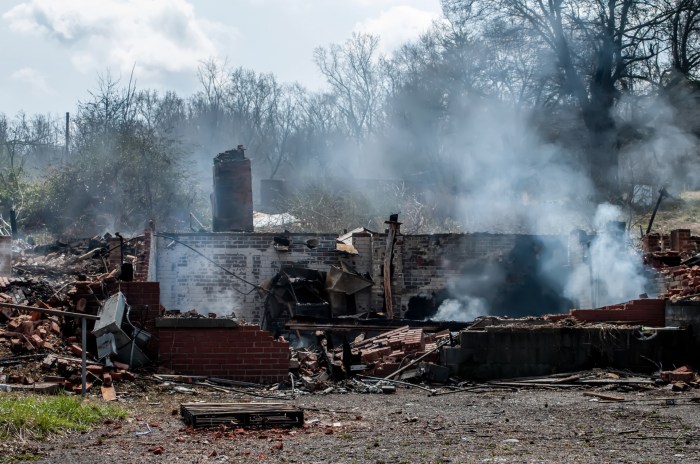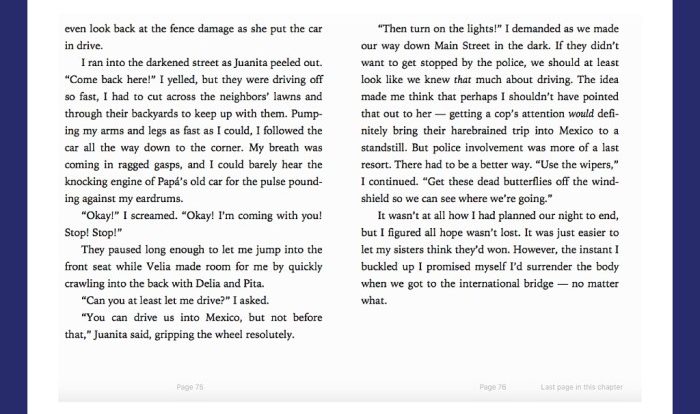Morning in the Burned House analysis delves into the profound themes of loss and resilience through the evocative imagery of a charred dwelling. The narrative unravels through fragmented memories and flashbacks, inviting readers to navigate the emotional complexities of a protagonist grappling with the aftermath of a devastating fire.
The burned house serves as a haunting symbol of shattered past and inner turmoil, reflecting the protagonist’s psychological state. The vivid sensory details and evocative language immerse readers in the visceral experience of the protagonist’s trauma.
Literary Symbolism

The burned house in the story is a potent symbol of loss and destruction. It represents the shattered past and the sense of emptiness that the characters experience in the wake of tragedy.
House as Shattered Past
- The house is described as “a ruin, a charred skeleton” (page 1). This description evokes a sense of loss and devastation, suggesting that the house has been irreparably damaged by the fire.
- The house is also described as “a place of memories” (page 2). This suggests that the house holds great significance for the characters, as it is a repository of their past experiences and emotions.
- The fire that destroyed the house is a metaphor for the loss of innocence and security that the characters have experienced. The fire has burned away their sense of safety and belonging, leaving them feeling lost and adrift.
House as Sense of Emptiness
- The house is described as “empty” (page 3). This description suggests that the house is devoid of life and purpose, reflecting the emptiness that the characters feel in their own lives.
- The characters are unable to return to the house after the fire, suggesting that they are unable to reclaim their past or find solace in the present.
- The house is a reminder of the fragility of life and the importance of cherishing the moments that we have.
Psychological Exploration: Morning In The Burned House Analysis
In the aftermath of the devastating fire, the protagonist is left in a state of profound emotional turmoil. The charred remains of their once-familiar abode become a haunting reflection of their shattered inner world.
The Burned House as a Symbol of Inner Turmoil
The burned house serves as a potent symbol of the protagonist’s psychological trauma. Its blackened walls and crumbling structure mirror the protagonist’s feelings of loss, emptiness, and despair. The absence of life and warmth within the house parallels the protagonist’s own sense of desolation and disconnection from the world.
The house’s charred and unstable state also reflects the protagonist’s fragile emotional state. The constant threat of collapse symbolizes the protagonist’s fears of losing control and falling apart. The unstable foundation of the house mirrors the protagonist’s own sense of insecurity and vulnerability.
Haunted by Memories and Loss
The protagonist’s memories of the fire and the life they lost haunt the burned house. These memories manifest as ghostly apparitions that torment the protagonist’s mind. The house becomes a constant reminder of the pain and trauma they have endured, preventing them from moving on.
The protagonist’s grief over the loss of their loved ones and possessions weighs heavily upon them. The burned house serves as a physical manifestation of this grief, a constant reminder of the irreparable damage that has been done.
Narrative Structure

The fragmented structure of “Morning in the Burned House” is essential to its storytelling. Flashbacks and disjointed memories create a disorienting and unsettling atmosphere, reflecting the protagonist’s own psychological state.
Non-Linear Narrative
The non-linear narrative forces readers to piece together events gradually, mirroring the protagonist’s fragmented memories. This technique enhances the sense of mystery and uncertainty, as readers are compelled to actively engage with the text to reconstruct the protagonist’s past.
Imagery and Sensory Details
The burned house in “Morning in the Burned House” is depicted with vivid and evocative language that creates a visceral and immersive experience for the reader. The sensory details used in the poem appeal to all five senses, creating a multi-sensory experience that transports the reader into the scene.
Visual Imagery
The poem’s visual imagery is particularly striking. The house is described as “blackened,” “charred,” and “empty,” conveying a sense of destruction and loss. The “red embers” and “ash” evoke the heat and intensity of the fire, while the “broken glass” and “twisted metal” suggest the violence of the event.
Auditory Imagery, Morning in the burned house analysis
The poem also employs auditory imagery to create a sense of atmosphere. The “crackling” of the embers and the “hiss” of the water on the fire create a sense of unease and tension. The “silence” of the house emphasizes the emptiness and desolation of the scene.
Tactile Imagery
The tactile imagery in the poem conveys the physical and emotional impact of the fire. The “hot” embers and “cold” ash evoke a sense of discomfort and danger. The “rough” walls and “broken” floor suggest the fragility and vulnerability of the house and its inhabitants.
Olfactory Imagery
The poem’s olfactory imagery creates a sense of decay and loss. The “smell of smoke” and “burnt wood” permeates the house, evoking the aftermath of the fire. The “scent of flowers” in the garden outside provides a contrast to the destruction within the house, highlighting the resilience of nature in the face of adversity.
Gustatory Imagery
The poem’s gustatory imagery is subtle but effective. The “bitter” taste of the ash and the “sour” smell of the smoke convey a sense of discomfort and unease. These sensory details contribute to the overall atmosphere of loss and desolation in the poem.
Themes and Motifs
Morning in the Burned House delves into a profound exploration of universal human experiences through the lens of central themes and recurring motifs.
Theme: Grief and Loss
Grief permeates the narrative, shaping the protagonist’s journey through the aftermath of tragedy. The burned house becomes a physical manifestation of the protagonist’s loss, a constant reminder of the devastating fire that claimed her family. The protagonist’s struggle to reconcile with the past and accept the loss serves as a poignant exploration of the complexities of grief.
Theme: Resilience and Transformation
Despite the profound loss, the protagonist exhibits remarkable resilience. Through the act of confronting her past and navigating the challenges of the present, she undergoes a transformative journey. The burned house becomes a symbol of both destruction and renewal, representing the protagonist’s capacity to rise from the ashes of adversity.
Theme: Search for Identity
The protagonist’s quest for self-discovery unfolds against the backdrop of the burned house. The loss of her family and the destruction of her home force her to question her sense of self and purpose. Through her interactions with others and her exploration of the past, she embarks on a journey of self-discovery, seeking to redefine her identity in the face of adversity.
Motif: The Burned House
The burned house serves as a recurring motif that connects the central themes of the narrative. It represents the protagonist’s loss, her resilience, and her search for identity. The house becomes a physical embodiment of the protagonist’s inner turmoil and her journey towards healing and renewal.
Character Analysis
The characters in “Morning in the Burned House” are deeply affected by the titular structure, which serves as a physical and psychological symbol of their experiences and emotions.
The protagonist, a young woman, has a complex relationship with the burned house. It represents both the trauma she has endured and the resilience she has developed in the face of adversity. Through her interactions with the house, she grapples with her memories of abuse and neglect, ultimately finding a sense of empowerment and self-discovery.
Secondary Characters
The secondary characters in the story play significant roles in shaping the protagonist’s perspective on the burned house. Her mother, a distant and emotionally unavailable figure, represents the source of her trauma. Her father, a well-meaning but ineffectual presence, symbolizes the inadequacy of the support she received during her childhood.
The protagonist’s interactions with these characters highlight the profound impact of familial relationships on an individual’s development. Through their flawed and often hurtful actions, they contribute to her feelings of isolation and shame, while also providing glimpses of the love and connection she craves.
Historical and Cultural Context

The burned house in “Morning in the Burned House” is a potent symbol that carries significant historical and cultural resonance. It evokes the horrors of war, the fragility of human life, and the indomitable spirit of those who have survived such devastation.
The Burned House as a Symbol of War
The burned house in the story is a stark reminder of the destruction and suffering inflicted by war. Its charred remains and crumbling walls bear witness to the violence that has torn through the community, leaving behind only ruin and despair.
The house becomes a symbol of the countless homes and lives lost during times of conflict, a poignant reminder of the human cost of war.
The Burned House as a Symbol of Resilience
Despite the devastation it represents, the burned house also serves as a symbol of resilience and hope. The story focuses on the experiences of those who have survived the horrors of war, and the burned house becomes a testament to their strength and determination.
It is a reminder that even in the face of adversity, the human spirit can endure and rebuild.
The Burned House in the Context of the Story
In the context of the story, the burned house is a central setting where the characters confront their past traumas and seek to find healing. The house becomes a physical manifestation of their emotional and psychological wounds, and the process of rebuilding it becomes a metaphor for their own journey of recovery.
Q&A
What is the significance of the burned house in the story?
The burned house represents the protagonist’s shattered past, emotional turmoil, and the search for identity.
How does the nonlinear narrative structure contribute to the story?
The fragmented memories and flashbacks create a sense of disorientation and uncertainty, mirroring the protagonist’s psychological state.
What are the central themes explored in the text?
The story explores themes of grief, resilience, the search for identity, and the enduring impact of trauma.

